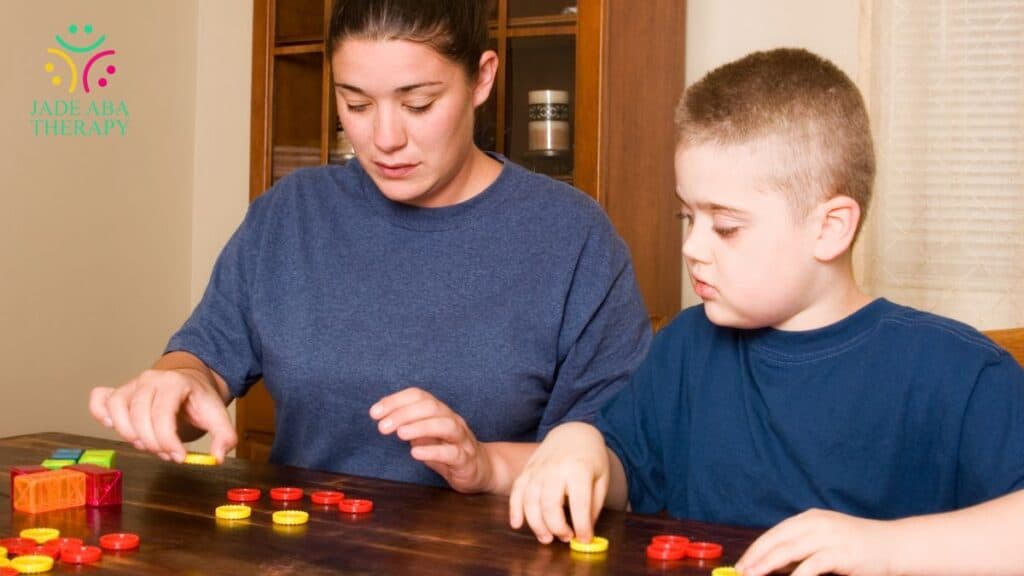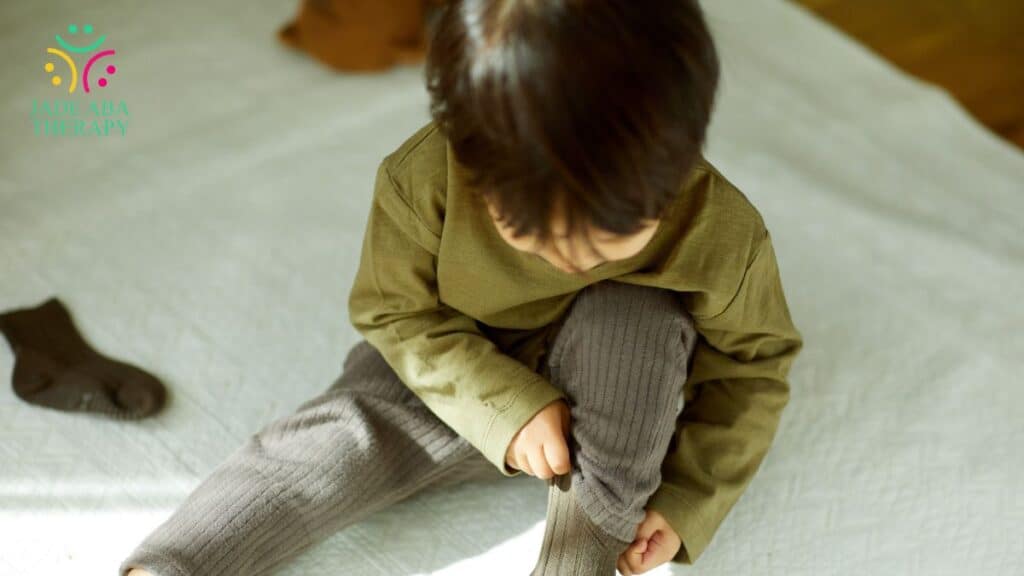Advanced ABA techniques help parents support language, play, and flexibility. FCT replaces problem behavior with requests, PRT builds skills through play, and RIRD redirects repetitive actions. Tools like product recording, latency tracking, and gradual exposure strengthen progress, reduce stress, and build independence.
What follows highlights approaches that turn daily challenges into opportunities for growth in communication, play, and independence.
Functional Communication Training (FCT): Replace Problem Behavior With Clear Requests
You know how tough it can be when a child’s behavior becomes their main way of asking for something? Functional Communication Training gives them a clearer, easier way to get their needs met.
Research shows advanced ABA techniques like FCT reduce severe behavior while building practical communication skills that last across settings. The process starts by figuring out what the behavior is trying to achieve. Is it escape, attention, items, or sensory input? Once that’s clear, a new, simple request is taught.
Reinforce Every Success Across Settings
Once the skill is learned, it’s practiced in different places and with different people. Early on, every attempt is rewarded. Later, reinforcement shifts to resemble real life.
Key strategies include:
- Practice across rooms and routines
- Caregivers using the same cues and rewards
- Gradually reducing reward frequency
- Teaching short waiting without losing the skill
Consistency helps the skill stick. If you’ve ever asked what is ABA therapy for autism, this technique is one of the most effective answers parents find useful.
Pivotal Response Training (PRT) For Natural Language And Play
Sure, learning happens best when it feels like play. Pivotal Response Training takes that idea and turns everyday moments into practice for language, play, and social skills. It’s one of the advanced ABA techniques often used to target pivotal areas like motivation and responding to multiple cues, which can boost progress across many related skills.
Use Child Choice and Quick Turns
Children stay engaged when their choices guide the activity. Fast turns keep the energy up, and rewards match the play itself. Here’s how it looks:
- Let the child choose the toy or game.
- Give clear, simple instructions.
- Mix easy and new tasks.
- Match rewards to the activity.
- Share control to prevent struggles.
This way, practice feels natural and fun, not forced.
Reward Attempts to Spark Initiations
Even an early try counts. When a child points, approximates a word, or presses a button, they still get the natural reward. That’s why initiations keep growing.
- Reinforce any genuine attempt.
- Give rewards quickly.
- Keep practice short and frequent.
- Use real-life routines for practice.
Parents often notice progress not just in language but also in play and social skills. That’s why PRT shows up often in ABA therapy examples. You might also see it help kids who engage in tactile stims, since it offers them a structured but flexible way to communicate instead.

Response Interruption and Redirection (RIRD) To Reduce Stereotypy
You might notice that some repetitive actions or sounds can get in the way of learning or social play. Response Interruption and Redirection gives children a quick alternative that helps them stay engaged.
As one of the advanced ABA techniques, RIRD is often used to reduce stereotypy while keeping participation in the activity going strong. When stereotypy starts, an adult briefly interrupts and gives a simple prompt. The child might:
- Answer an easy question.
- Copy a movement.
- Name a familiar item.
Prompts are fast, last only a few seconds, and then the child goes back to the original task.
Reinforce the Alternative So It Sticks Less
The replacement response works best when it earns attention or activity access, while stereotypy no longer does.
- Use short, easy responses.
- Give immediate reinforcement.
- Fade prompts as success builds.
- Reinforce with natural outcomes like play or conversation.
Families sometimes see this approach reduce behaviors tied to autism clothing preferences or routines, since children learn more flexible ways to respond. For anyone asking what is ABA therapy for autism, RIRD is one clear example of turning challenges into learning opportunities.

Advanced ABA Techniques at Home: Permanent Product Recording and Latency ABA
Parents often ask how progress can be measured outside of formal sessions. Two practical strategies, permanent product recording and latency ABA, make it easier to track gains in everyday routines without constant supervision.
Snap Photos, Count Results, Track Gains
Permanent product recording relies on the results left behind. That might be:
- Finished worksheets
- A cleaned bedroom
- A completed toothbrushing chart
- Labeled storage containers
Taking timestamped photos or jotting quick counts means you don’t need to watch every second. The evidence is there, ready to review later.
Time From Cue to Action for Faster Starts
Latency ABA looks at how long it takes a child to begin after a cue. For example, a timer starts when you say “Shoes on” and stops at the first movement. Tracking this helps show whether prompts or visuals reduce delays.
Setting small goals, like cutting start times in half, and pairing them with natural rewards, such as getting first choice of a game, makes transitions smoother at home.
Sensory Progress With Graduated Exposure and Stimulus Fading
Sensory sensitivities often shape daily routines, especially when it comes to clothes. Respecting autism clothing preferences while slowly expanding tolerance can make mornings and school days less stressful.
Research links tactile sensitivity to participation challenges, which is why gradual change works better than forcing long wear times.
Respect Clothing Preferences and Comfort
Small adjustments go a long way. Families can:
- Check seams, tags, and fabrics.
- Adjust fit for comfort.
- Pair small changes with favorite routines.
- Fade in new textures slowly.
Stimulus fading and graded exposure help introduce clothing step by step, always matched with reinforcement. This reduces distress while still meeting dress codes or hygiene needs.
Behavioral studies show similar methods support medical goals like mask wearing and needle tolerance. That’s why families often see this approach highlighted in ABA therapy examples, especially for everyday challenges that affect comfort and independence.

Frequently Asked Questions
What is the highest level of ABA?
The highest level of ABA credential is the Board Certified Behavior Analyst (BCBA). A doctoral-level designation, BCBA-D, also exists but is not a separate certification and does not expand practice rights. Both BCBA and BCBA-D serve as independent practitioners where permitted by state law.
Can I become a therapist with an ABA degree?
Yes. You can become a therapist with an ABA degree by completing a qualifying graduate program, supervised fieldwork, and passing the BCBA exam. State licensure may also be required. Bachelor’s-level roles exist but have limited scope. Always confirm BACB and state requirements before pursuing enrollment.
Is an ABA degree worth it?
Yes. An ABA degree is worth it because demand for BCBAs has risen steadily for over a decade, with national data showing strong job growth. All 50 states mandate autism coverage in health plans, and Medicaid EPSDT can fund ABA for children. Value depends on fit, licensure, and career goals.
Building Progress Step by Step
Growth often happens in the small, everyday moments where children practice new ways to connect and respond. Techniques like FCT, PRT, and RIRD show how consistent support can ease challenges while strengthening independence. Families looking into ABA therapy in Maryland often find these approaches helpful because they blend naturally into routines at home, school, and play.
Jade ABA Therapy works alongside parents to put these methods into action in ways that fit each child’s needs. Reach out today to start building meaningful progress together.




